通过熔盐合成法合成的球状和棒状 PbTiO3 粉末的结构特征和介电特性
摘要
通过 PbC2O4 和 TiO2 在共晶 NaCl-KCl 盐中的反应,分别通过熔融盐合成 (MSS) 和模板 MSS 方法合成了球状和棒状 PbTiO3 (PTO) 粉末。 X 射线衍射图显示所有 PTO 粉末均以四方相结构结晶。在 MSS 工艺中将 PbC2O4:TiO2:NaCl:KCl 的摩尔比从 1:1:10:10 增加到 1:1:60:60 对 950 °C 合成的 PTO 粉末的球形形态影响不大5 小时。以棒状锐钛矿 TiO2 前驱体为模板,在 800 °C、5 h 条件下合成了直径为 480 nm-1.50 μm、长度可达 10 μm 的大规模多晶棒状 PTO 粉末。 PbC2O4:TiO2:NaCl:KCl的摩尔比等于1:1:60:60。 X 射线能量色散谱表明所有 PTO 粉末均由 Pb、Ti 和 O 元素组成,测得的 Pb:Ti 原子比接近 1:1。在模板 MSS 过程中,熔盐含量在形成棒状 PTO 粉末方面起着重要作用。在低熔盐含量下,即使使用棒状TiO2模板也无法合成棒状PTO粉末。此外,延长反应时间抑制了棒状 PTO 粉末的形成,但促进了球状 PTO 纳米粒子的形成。对球状和棒状 PTO 粉末的介电性能进行了比较研究。在室温下,以 PbC2O4:TiO2:NaCl:KCl 摩尔比为 1:1:30:30 用 MSS 法合成的球形 PTO 粉末的介电常数和介电损耗分别为~ 340 和 0.06(在 10 6 赫兹),分别。通过模板 MSS 法合成的棒状 PTO 粉末的相应值分别为 140 和 0.08,PbC2O4:TiO2:NaCl:KCl 的摩尔比为 1:1:60:60。目前的结果表明球形PTO粉末具有更好的介电性能,在多层电容器和谐振器领域具有广阔的应用前景。
介绍
具有通式ABO3的钙钛矿氧化物是固态化学中最重要的一类材料,已广泛应用于铁电、磁性、光电子和能量转换等领域[1,2,3]。在钙钛矿氧化物家族的所有成员中,PbTiO3 (PTO) 具有最高的四方畸变 (c /a ~ 1.064),这使它比其他人更出色。这种大的四方畸变对应于所有铁电钙钛矿氧化物中最高的自发极化。作为钙钛矿铁电氧化物的范例,PTO 具有优异的介电、压电和热电特性 [4, 5]。然而,由于PTO陶瓷的热膨胀不匹配、机械拉伸力和微裂纹等问题,纯PTO陶瓷难以制备成高密度和单片陶瓷。在过去的十年中,许多工作致力于通过各种途径合成 PTO 粉末,例如固态反应 [6]、溶胶-凝胶法 [7、8]、水热法 [9、10]、 Pechini 法 [11]、共沉淀法 [12] 等。然而,在所有这些方法中,需要在或多或少的高温下煅烧以获得纯结晶铁电 PTO。不幸的是,高温煅烧通常会产生具有粗粒度的团聚粉末,这需要额外的研磨过程。研磨过程中的污染和其他不良特征会在制成的产品中产生缺陷,从而破坏 PTO 陶瓷的电性能。
熔盐合成(MSS)法是制备钙钛矿氧化物电子陶瓷粉体的有效方法,该方法涉及以熔盐为介质,在相对较低的温度和较短的时间内由其组成材料(氧化物和碳酸盐)合成纯钙钛矿氧化物。与常规固态反应相比的反应时间 [13]。最近,钙钛矿 PTO 粉末是通过熔融助熔剂反应合成的,使用 NaCl 和 NaCl-KCl 作为反应介质 [14,15,16]。球形 PTO 粉末的形成是通过溶解的 PbO 扩散到熔融盐中的 TiO2 表面并原位反应形成 PTO 纳米颗粒,然后跟随 PTO 纳米颗粒的成核和生长来实现的。与 PTO 粉末相比,通过 MSS 方法合成 PTO 1D 纳米材料(例如,纳米棒、纳米线和纳米管)已经远远落后。主要原因是由于钙钛矿结构的高度对称性很容易导致 PTO 生长成立方块,因此在合成高质量的 PTO 1D 纳米材料方面存在挑战。迄今为止,文献中只有少数关于通过 MSS 方法合成 PTO 1D 纳米材料的工作。邓等人。 [17] 通过在 NaCl 熔盐介质中使用表面活性剂(聚氧乙烯(9)壬基苯基醚,NP-9)辅助方法,在 700 °C 下合成了直径为 50-80 nm 和几微米长度的 PTO 纳米棒。 PTO 纳米棒的生长归因于细小的 PTO 纳米颗粒的分散及其在较大颗粒上的重新沉积,导致在 NP-9 表面活性剂和 NaCl 通量的共同作用下沿轴向形成纳米棒。蔡等人。 [15] 报道了通过模板 MSS 方法合成直径为 0.1-1.0 μm 和长达几微米的单晶 PTO 纳米棒,其中 NP-9 用作表面活性剂,棒状 TiO2 前驱体是用作钛源的模板。棒状 TiO2 模板的尺寸和形态保留在合成的 PTO 颗粒中。同样,针状 PTO 粉末也通过模板 MSS 方法合成,其中纯针状 TiO2 颗粒用作模板 [18]。模板MSS法在800 °C合成的针状PTO颗粒长度为30-100 μm,直径为500 nm-2.0 μm。
尽管以上报道了通过 MSS 法和模板 MSS 法合成 PTO 纳米材料,但关于 PTO 粉末介电性能的数据很少。此外,模板MSS法形成PTO纳米棒的机理还不是很清楚。在这项工作中,我们报告了通过(模板)MSS 方法通过 PbC2O4 和 TiO2 在共晶 NaCl-KCl 盐中反应合成球状和棒状 PTO 粉末,而不使用 NP-9 表面活性剂。详细研究了模板MSS方法的工艺参数如反应时间和熔盐含量对棒状PTO粉末形成的影响。结果表明,熔盐含量在模板MSS过程中形成具有立方或假立方晶体结构的棒状ABO3化合物中起着关键作用。在低熔盐含量下,即使在模板 MSS 过程中使用棒状 TiO2 模板,也无法合成 PTO 纳米棒。还比较了MSS法和模板MSS法合成的球状和棒状PTO粉体的介电性能,结果表明球状PTO粉体具有更好的介电性能。
方法
材料
PbC2O4 和 TiO2 分析级试剂(具有球形形态和锐钛矿和金红石混合相结构)购自西格玛奥德里奇(上海)贸易有限公司。 NaCl 和 KCl 盐、K2CO3、AgNO3、盐酸溶液购自上海化学试剂有限公司
MSS 法合成球形 PTO 粉末
球形 PTO 粉末是通过 MSS 方法通过 PbC2O4 和 TiO2 在共晶 NaCl-KCl 盐中的反应合成的。 PbC2O4:TiO2:NaCl:KCl的摩尔比选择为1:1:10:10、1:1:20:20、1:1:30:30、1:1:40:40和1:1 :60:60。将 PbC2O4、TiO2、NaCl 和 KCl 的混合物在研钵和研杵中研磨 30 分钟,然后在氧化铝坩埚中加热至 950 °C 并保持 5 小时。最后,将产物在炉内自然冷却至室温,用去离子水洗涤数次,直至AgNO3溶液检测不到游离氯离子,以确保完全去除盐分。洗涤后,产物在120 ℃下干燥4 h进行结构表征。
模板 MSS 法合成棒状 PTO 粉末
通过模板MSS方法合成棒状PTO粉末,其中棒状锐钛矿TiO2颗粒用作钛源。棒状 TiO2 模板由棒状 K2Ti4O9 制备,遵循 Hayashi 等人先前报道的程序。 [19]。首先将K2CO3氧化物与TiO2氧化物以1:3的摩尔比混合,然后将混合物在1000 ℃下加热并保持18 小时。最后,产物在炉内自然冷却至室温,用去离子水洗涤数次,除去残留的K2CO3。得到的K2Ti4O9主产物在70 ℃HCl溶液(浓度1 M)中洗涤2 h提取K2O,得到TiO2·nH2O相,在600 ℃、700 ℃退火1 h和 800 °C,分别获得棒状 TiO2 化合物。然后,PbC2O4 与棒状 TiO2 模板和 NaCl-KCl 熔盐混合,摩尔比为 PbC2O4:TiO2(模板):NaCl:KCl 等于 1:1:20:20 和 1:1:60:60,分别。将两种混合物在 800 °C 下退火不同的小时(例如,1 h、5 h 和 10 h)。最终产品按上述类似步骤洗涤和干燥。
微观结构表征
通过 X 射线粉末衍射(Rigaku D/Max-RA,Cu Kα 辐射)表征所制备的 PTO 粉末的相结构。步长为每秒 0.01°,2θ 范围为 15-70°。使用配备 X 射线能量色散光谱 (EDS)(EX-250 光谱,HORIBA Corporation)的扫描电子显微镜(SEM,Hitachi S-3400 N II,30 kV)检查 PTO 产品的表面形貌检测。 SEM样品通过将粉末撒在碳带上,然后根据需要涂上金来制备。
介电测量
对于介电性能测量,干燥的球状和棒状 PTO 粉末在 7 MPa 的压力下被压制成直径 12 mm 和 1.0 mm 厚的颗粒,然后在空气中在 1150 °C 下退火 2 小时。随后,对退火颗粒的表面进行研磨和抛光,然后在两个表面上涂上银浆。然后将银浆在 550 °C 下焙烧 60 分钟。使用Agilent 4192 A阻抗分析仪在室温10 Hz至1 MHz下测量退火后的PTO粉末的介电常数和介电损耗。
结果与讨论
MSS法合成的PTO粉末的相结构和形貌
MSS 法合成的 PTO 粉末在 950 °C 下在不同熔盐含量下 5 h 的 XRD 图如图 1 所示。 06–0452,P 4毫米 空间群,晶格常数a =0.390 nm 和 c =0.415 nm),并且没有检测到其他杂质相。通常,在 2θ =45° 区域的 XRD 图案是存在立方或四方钙钛矿结构的特征。在这种情况下,立方 (200) 在大约 2θ =45 ° 处分裂为四方 (200) 和 (002) 反射 清楚地观察到,表明纯四方铁电相的形成。晶格参数 (a 和 c ) 的四方 PTO 粉末可以通过以下公式计算:
$$ \frac{1}{d^2}=\frac{h^2+{k}^2}{a^2}+\frac{l^2}{c^2} $$ (1)其中 d 是相邻 (hkl ) 平面,和 a 和 c 是四方相结构中的晶格参数。晶格参数a 从 XRD 图案计算出的 PTO 粉末在 0.3905-0.3911 nm 范围内,并且 c 在 0.4077–0.4089 nm 的范围内。详细信息见表 1。c /a 比值在 1.043-1.047 范围内,平均值为 1.045,小于 PTO 单晶的 1.064。从图1所示的XRD图谱可以看出,PTO粉末的相结构不受熔盐含量的影响。所有 PTO 粉末均以具有 P 空间群的四方相结构结晶 4毫米 .最近,通过CALYPSO(Crystal structure AnaLYsis by Particle Swarm Optimization)结构搜索方法结合密度泛函理论计算对钙钛矿PTO从0D团簇到3D晶体的结构演化的理论研究表明,PTO的基态结构在环境压力下是 P 4毫米 PTO 簇和 2D PTO 双层的相和准平面结构在环境压力下也是稳定的 [20]。 PTO 粉末的 SEM-EDS 检查如图 2 所示。图 2a-e 中显示的 SEM 图像显示 PTO 粉末主要由许多球状纳米颗粒组成,只有少数棒状颗粒。随着 PbC2O4:TiO2:NaCl:KCl 的摩尔比从 1:1:10:10 增加到 1:1:60:60,PTO 粉末的形态没有明显变化,如图 2a-e 所示。这意味着,不同量的相同熔盐仅作为反应介质,它们只对反应离子的扩散速率产生影响。共晶 NaCl-KCl 熔盐(共晶熔点 650 °C)提供了相对低温的液相反应环境,这有助于 MSS 过程中反应物离子的传输。据报道,反应物在熔盐中的溶解度在 MSS 过程中起着重要作用,它严重影响反应速率和合成产物的形貌 [13]。在目前的工作中,PbO 在 400–500 °C 的温度下通过化学反应从 PbC2O4 中分解 [14]
$$ {\mathrm{PbC}}_2{\mathrm{O}}_4\to \mathrm{PbO}+\mathrm{CO}\uparrow +{\mathrm{CO}}_2\uparrow $$ (2)其在 NaCl-KCl 熔盐中的溶解度(在 900 °C 时 NaCl-KCl 盐中的溶解度为 30 μmol/g 氯化物 [21])比 TiO2(在碱金属氯化物中的溶解度非常低 [22])更高。因此,熔盐中溶解度更高的反应物 PbO 可以扩散到球状 TiO2 前驱体的表面,并通过溶液沉淀过程与其原位反应形成球状 PTO 粉末。图 2f 所示的典型 EDS 光谱表明样品由 Pb、Ti 和 O 元素组成,EDS 分析证实化学成分与标称的几乎相似。
<图片>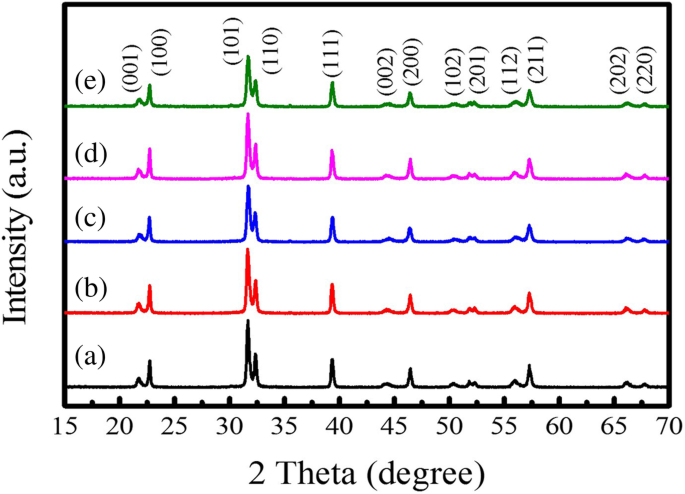
通过 MSS 方法在 950 °C 下 5 h 合成的球状 PTO 产物的 XRD 图谱,PbC2O4:TiO2:NaCl:KCl 的摩尔比等于 (a) 1:1:10:10, (b) 1:分别为1:20:20、(c) 1:1:30:30、(d) 1:1:40:40、(e) 1:1:60:60
<图片>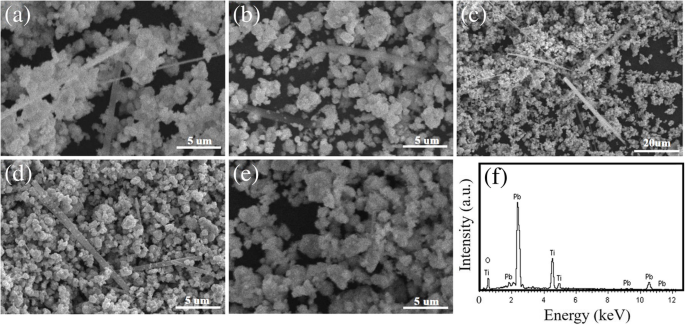
采用MSS法在950 °C下5 h合成球状PTO产品的SEM图像,PbC2O4:TiO2:NaCl:KCl的摩尔比等于a 1:1:10:10,b 1:1:20:20,c 1:1:30:30,d 1:1:40:40 和 e 分别为 1:1:60:60。 f PbC2O4:TiO2:NaCl:KCl摩尔比为1:1:10:10,在950 °C下合成5 h的球状PTO产物的典型EDS光谱
模板 MSS 法合成棒状 PTO 粉末的相结构和形貌
在通过模板 MSS 法合成棒状 PTO 粉末之前,首先研究了 TiO2 模板的相结构和形貌。图 3 展示了在不同温度下退火 1 小时的 TiO2 模板的 XRD 图案。据观察,在 600 °C(图 3a)和 700 °C(图 3b)退火后,产品中形成了 TiO2 的主要锐钛矿相。但是,产品中仍保留有一定量的K2Ti4O9。星号表示的 XRD 衍射峰源自 K2Ti4O9 相(ICDD 编号 32-0861)。随着退火温度升高到 800 °C(图 3c),不纯的 K2Ti4O9 相几乎消失了。图 3c 中显示的所有 XRD 衍射峰都可以很好地指向锐钛矿 TiO2(JCPDS No.021-1272),表明纯锐钛矿相 TiO2 的形成。还注意到由于(101)主衍射峰的强度大大增加,TiO2模板的结晶质量得到了很大改善。图 4 显示了在不同温度下退火的 TiO2 模板的 SEM 图像。所有的 TiO2 模板都表现出棒状形态,随着退火温度的升高,它们的平均直径从 490 nm 到 570 nm 再到 500 nm,而它们的平均长度保持在 12.0 μm 左右。在 600 °C、700 °C 和 800 °C 下退火的 TiO2 模板的纵横比分别约为 25、23 和 24。退火后的 TiO2 模板的棒状形态归因于退火过程中锐钛矿相结构的各向异性生长。基于以上实验结果,可以得出结论,锐钛矿相TiO2模板在800 °C下退火1 h具有较高的结晶度和棒状形态,易于通过模板MSS法合成棒状PTO粉末.
<图片>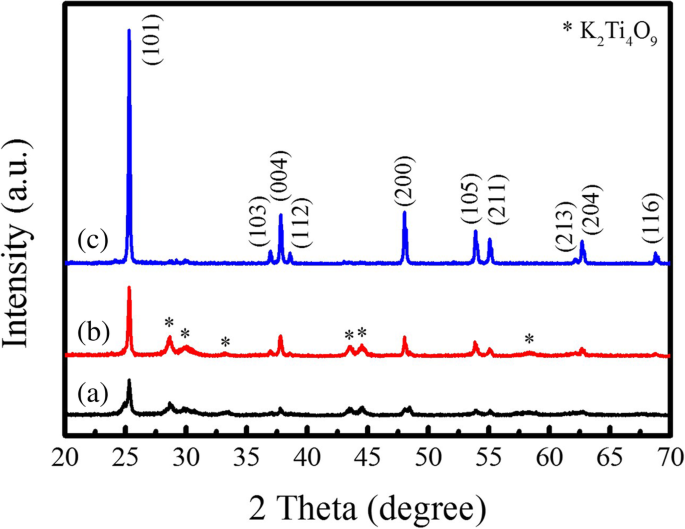
TiO2模板在(a) 600 °C、(b) 700 °C和(c) 800 °C退火1 h后的XRD图
<图片>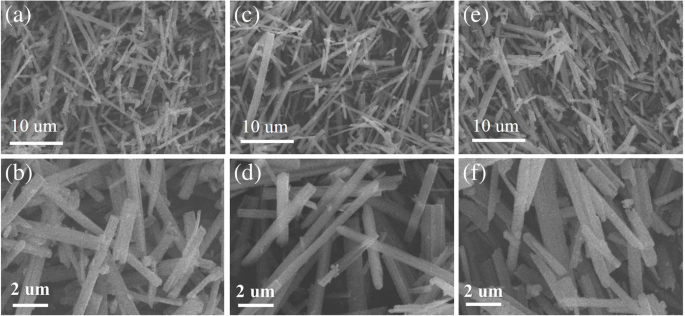
在 a 退火的 TiO2 模板的 SEM 图像 , b 600 °C; c , d 700 °C;和 e , f 800 °C 1 h
图 5 显示了在 800 °C 下通过模板 MSS 法合成的 PTO 粉末的 XRD 谱图,其中棒状 TiO2 模板(锐钛矿相在 800 °C 下退火 1 h)用作钛源和PbC2O4:TiO2(模板):NaCl:KCl的摩尔比等于1:1:20:20。 XRD 衍射图显示所有 PTO 粉末以四方相结构(JCPDS No. 06-0452)结晶,没有检测到其他杂质相,说明形成了纯四方相结构。 PTO 粉末的晶格参数是从 XRD 谱中推导出来的,详细信息见表 2。PTO 粉末的相应 SEM 图像如图 6 所示。如图 6a 所示,退火后的 PTO 粉末的形貌在 800 °C 下持续 1 h 是少量棒状和大量球状 PTO 颗粒的组合。棒状PTO颗粒的定性体积分数仅为3%左右,棒状PTO颗粒的平均直径约为860 nm,长度为4.50 μm。然而,随着反应时间从 1 h 增加到 5 h,棒状 PTO 颗粒的体积分数降低到~ 2.4%(图 6c),棒状 PTO 颗粒的平均直径约为 930 nm 和 6.0 μm 的长度。进一步将反应时间延长至 10 h(图 6e),在 PTO 产物中几乎观察不到棒状 PTO 颗粒,而形成了大量球状 PTO 颗粒(见图 6e-f)。这意味着,延长反应时间会促进球形 PTO 颗粒的形成,而抑制棒状 PTO 颗粒的形成。在 800 °C 下退火 10 h 的球形 PTO 颗粒的平均粒径约为 550 nm(图 6e),略大于棒状 TiO2 模板的直径(480 nm)(图 4e)。 800 °C 10 h退火产物中大量球形PTO颗粒的形成可归因于模板MSS过程中棒状TiO2模板破碎成小球形颗粒,与溶解的PbO反应( PbC2O4) 在 NaCl-KCl 熔盐中分解,通过溶液沉淀机制形成球形 PTO 粉末。图 6b 和 d 中观察到 TiO2 模板的断裂痕迹,其中一些球形 PTO 颗粒连接在一起形成了糖葫芦的形状。在低熔盐含量下,模板MSS法似乎没有成功合成棒状PTO粉末。
<图片>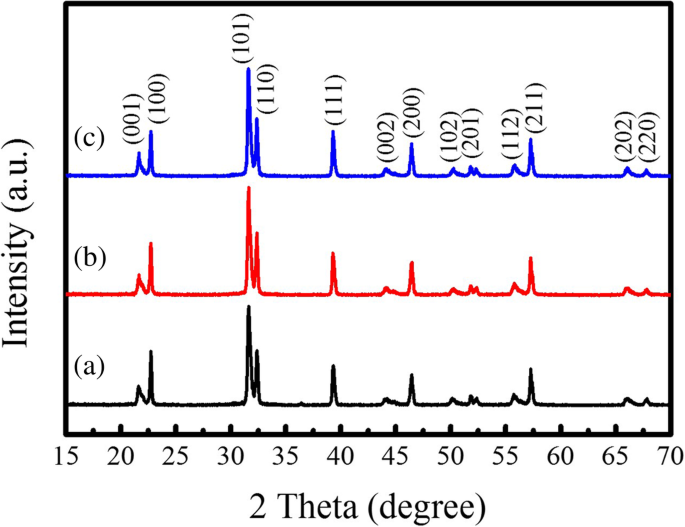
通过模板 MSS 方法合成的 PTO 粉末的 XRD 谱,PbC2O4:TiO2(模板):NaCl:KCl 的摩尔比等于 1:1:20:20,在 800 °C 下(a)1 h,(b) 5 h 和 (c) 10 h
<图片>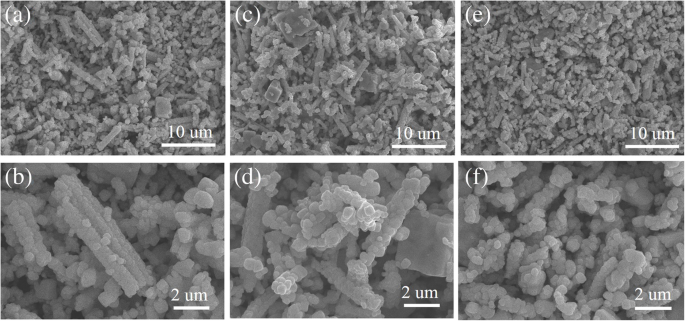
通过模板 MSS 方法合成的 PTO 产品的 SEM 图像,PbC2O4:TiO2(模板):NaCl:KCl 的摩尔比等于 1:1:20:20,并在 800 °C 下退火 a , b 1 小时; c , d 5 小时;和 e , f 10 h
众所周知,在 MSS 工艺中,晶粒在高温下通过熔盐通量生长,熔盐含量控制着晶粒生长速率和最终产品的形貌 [23]。随着熔盐含量的增加,在高温下会形成大量的熔盐液体。因此,溶解的反应离子(例如铅离子)在熔盐液体中被有效分离,并且它们的浓度需要更长的时间才能达到饱和浓度。因此,应降低不溶性 TiO2 模板颗粒表面 PTO 纳米微晶的成核率。形成的 PTO 纳米微晶有足够的时间在高熔盐含量环境下将它们重新组合成棒状 PTO 颗粒。这意味着,高熔盐含量环境有助于在模板 MSS 过程中合成棒状 PTO 颗粒。因此,我们将 PbC2O4:TiO2(模板):NaCl:KCl 的摩尔比增加到 1:1:60:60,并将它们的混合物在 800 °C 下退火不同的小时。图 7 展示了在高熔盐含量下通过模板 MSS 方法在 800 °C 下合成的 PTO 粉末的 XRD 谱。发现 PTO 粉末在 800 °C 下退火 5 h(图 7b)和 10 h(图 7c)具有纯四方相;然而,在 800 °C 下退火 1 h 的 PTO 粉末(图 7a)除了少量的 Ti3O5 和 TiO2 不纯相外,具有主要的四方相。晶格常数a 和 c 计算了在 800 °C 下退火不同小时的 PTO 粉末的百分比,并将其列在表 2 中。c /a 比率约为 1.050。相应的 PTO 粉末的表面形貌如图 8 所示。在图 8a 中观察到,在 800 °C 下退火 1 h 的 PTO 粉末由棒状和球状颗粒组成。从 SEM 图像估计的棒状颗粒的定性体积分数约为 70%。棒状颗粒的直径从480 nm到1.50 μm不等,而它们的长度在3.0-7.0 μm的范围内。图 8b 所示的局部放大 SEM 图像显示棒状 PTO 粉末由非常小的 PTO 纳米微晶组成,表明在模板 MSS 过程中棒状 TiO2 模板的断裂痕迹。随着反应时间从 1 h 增加到 5 h,最终产品中棒状 PTO 粉末的体积分数增加到~ 97%(图 8c)。棒状 PTO 粉末的长度在 7.0-10.0 μm 的范围内。然而,进一步将反应时间增加到 10 h(图 8e),最终产品中棒状 PTO 颗粒的体积分数约为 85%,并且 PTO 棒的长度在 3.5– 6.5 μm。棒状PTO粉末的直径在970 nm-1.50 μm范围内。
<图片>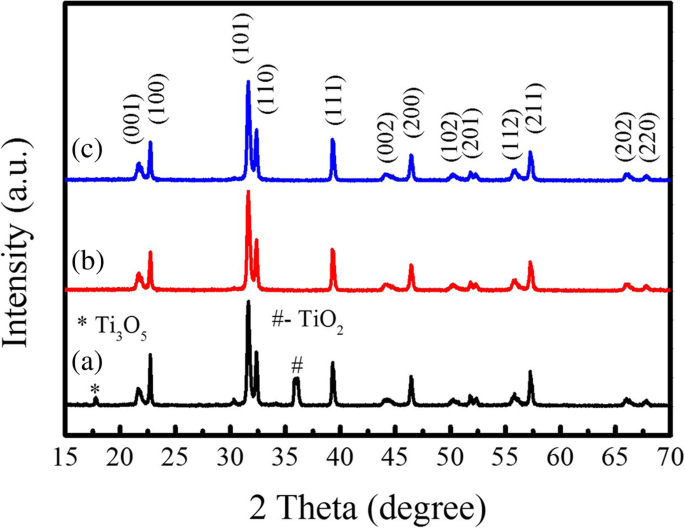
通过模板 MSS 方法合成的 PTO 粉末的 XRD 图谱,PbC2O4:TiO2 (模板):NaCl:KCl 的摩尔比等于 1:1:60:60 并在 800 °C 下退火 (a) 1 h, (b ) 5 h, 和 (c) 10 h
<图片>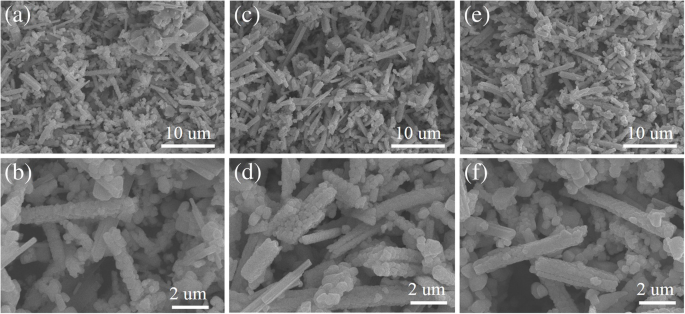
通过模板 MSS 法合成的 PTO 粉末的 SEM 图像,PbC2O4:TiO2(模板):NaCl:KCl 的摩尔比等于 1:1:60:60,在 800 °C 下 a , b 1 小时; c , d 5 小时;和 e , f 10 h
通过模板 MSS 方法在高熔盐含量下形成棒状 PTO 粉末可以通过以下过程来理解。在模板MSS过程中,PbC2O4首先在400~500 ℃的温度范围内分解为PbO、CO和CO2,PbO在800 ℃下溶解于熔盐液中(其在NaCl-KCl盐中的溶解度为14 μmol/g 氯化物在 800 °C [21])。溶解的PbO扩散到棒状TiO2模板表面,在800 °C下通过化学反应与TiO2原位反应形成PTO纳米微晶
$$ \mathrm{PbO}+{\mathrm{TiO}}_2\to {\mathrm{PbTiO}}_3 $$ (3)由于熔盐含量很高(PbC2O4:TiO2(模板):NaCl:KCl的摩尔比等于1:1:60:60),所以溶解的铅离子在熔盐液中被有效分离,其浓度需要更长的时间才能达到饱和浓度。棒状 TiO2 模板在 NaCl-KCl 盐中的溶解度非常低,在高熔盐含量环境下,在高温下分解成小的 TiO2 球形颗粒。因此,溶解的 PbO 在其表面与破碎的 TiO2 颗粒反应形成 PTO 纳米微晶。这些 PTO 纳米微晶有足够的时间在高熔盐含量环境下将它们重新组合成棒状 PTO 颗粒。如图 8c 所示,合成了直径在 480 nm–1.50 μm 范围内、长度可达 10 μm 的大规模多晶棒状 PTO 粉末。如图 8d 所示,它们由小的纳米微晶组成。图 9 显示了 MSS 工艺中 PTO 颗粒的形成和模板 MSS 工艺中棒状 PTO 粉末的形成示意图。我们目前的工作表明,熔盐含量在形成棒状 PTO 过程中起着关键作用。模板MSS过程中具有立方或拟立方晶体结构的ABO3化合物。也就是说,在低熔盐含量下,即使在模板 MSS 工艺中使用棒状 TiO2 模板,也无法合成棒状 PTO 粉末。多晶棒状PTO粉末的形成糖葫芦状而不是单晶PTO棒仍有待进一步研究。
<图片>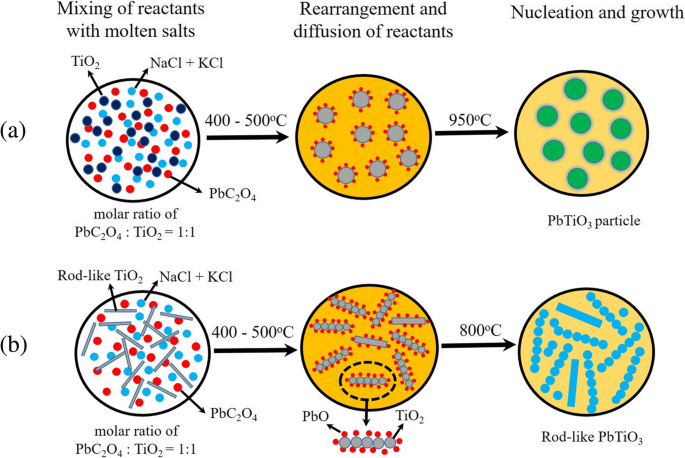
(a) MSS过程中PTO颗粒和(b)模板MSS过程中棒状PTO粉末的形成示意图
球形和棒状 PTO 粉末的介电特性
介电常数 (εr ) 和介电损耗 (tanδ 通过 MSS 和模板 MSS 方法合成的球形和棒状 PTO 粉末的 ) 如图 10 所示,其在室温下作为频率的函数进行测量。在球形和棒状 PTO 粉末中观察到类似的频率相关介电行为。如图 10a 所示,通过 MSS 方法在 950 °C 下 5 h 合成的球状 PTO 粉末(a)和(b),PbC2O4:TiO2:NaCl:KCl 的摩尔比等于(a)1:分别为 1:30:30 和 (b) 1:1:60:60 的介电常数比通过模板 MSS 方法在 800 °C 下合成的棒状 PTO 粉末 (c) 和 (d) 高得多,对于(c ) 5 h 和 (d) 10 h,其中 PbC2O4:TiO2(模板):NaCl:KCl 的摩尔比等于 1:1:60:60。注意到球状PTO粉末(a)和(b)的介电常数在低于10 3 的频率范围内迅速下降(从~ 3000到~ 700) Hz,然后随着频率的进一步增加而缓慢降低超过 10 3 Hz, and finally become a constant value of ~ 340 at a higher frequency over 10 5 赫兹。 The fast decrease of the dielectric constant at lower frequencies is ascribed to the space charge polarization effect, which is correlated to the non-uniform charge accumulation at grain boundaries within the sphere-like PTO powders. The slow reduction of the dielectric constant is due to that the dipoles present in the PTO powders could not reorient themselves as fast as the frequency of an alternating electric field, resulting in a decrease of the dielectric constants [24]. In contrast, the rod-like PTO powders (c) and (d) synthesized by template MSS method exhibit a slight frequency-dependent dielectric behavior, their dielectric constants are slightly reduced with increasing frequency below 10 3 Hz, and then become a constant value of ~ 140. It is observed in Fig. 10b that all the dielectric losses of the spherical and rod-like PTO powders are decreased with increasing frequency due to the existence of the space charge polarization in all the PTO powders. The dielectric loss of the PTO powder (b) has the highest value, which has reduced fast with increasing frequency below 10 5 Hz, and then it becomes constant. The dielectric losses of the PTO powder (a) are reduced slowly with increasing frequency, which has the lowest value as compared with the other three PTO samples. The dielectric losses of the spherical PTO powders (c) and (d) synthesized by template MSS method exhibit very similar dielectric behavior, their dielectric losses are reduced slowly as the frequency increases. At room temperature, the dielectric constant and dielectric loss of the spherical PTO powders (a) measured at 10 6 Hz were ~ 340 and 0.06, respectively. The corresponding values for the spherical PTO powders (b) were 155 and 0.12, 140 and 0.08 for the rod-like PTO powders (c), and 130 and 0.07 for the rod-like PTO powders (d). Therefore, the sphere-like PTO powders (a) have high dielectric constant and low dielectric loss, and these dielectric data are better than that reported previously for the PTO nanoparticles synthesized via sol-gel process and annealed at 600 °C for 6 h (the dielectric constant and dielectric loss at 10 6 Hz were about 15 and 0.40) [25], and for the PTO nanoparticles synthesized by stearic acid gel method and annealed at 400 °C for 1 h (the dielectric constant and dielectric loss at 10 6 Hz were about 50 and 0.002) [26]. Normally, to measure the dielectric properties of PbTiO3 ceramics prepared from the nanopowders synthesized by chemical methods such as the sol-gel method [27], hydrothermal method [28, 29], or by physical method such as high-energy ball milling technique [30], PbTiO3 powder samples are usually pressed into pellets under a hydraulic press (using 1 cm diameter die). For making dense PbTiO3 ceramics, the samples are needed to be sintered at high temperatures (e.g., 900 °C or 1000 °C for 2 h in air) followed by furnace cooling. Leonarska et al. [28] synthesized the PTO nanopowders at 490 K for 2 h by hydrothermal method and then prepared the PTO ceramics from the as-synthesized PTO nanopowders and sintered it at 1240 K for 1.5 h. They checked the impact of high-temperature process on the morphology or crystallization degree of the PTO ceramics by SEM observations and found that the PTO ceramics had slightly larger and rounded ceramic grains in comparison with the nanoparticles obtained directly from hydrothermal method. Similarly, Hu et al. [29] also reported the preparation of PTO nanoceramics (with grain sizes of ~ 200 nm) under sintering process (at 950 °C for 2 h in air) using the hydrothermal PTO nanopowders (with average grain size of ~ 100 nm) as the raw materials. This result indicates the sintering process of the hydrothermal PTO nanopowders can increase the grain size.孔等人。 [30] prepared the PTO nanopowders (with average grain size of ~ 10 nm) by high-energy ball milling technique, and pressed them directly into green pellets and sintered at 1100 °C for 1 h. Crack-free PTO ceramics with 95% of the theoretical density were successfully obtained. SEM images revealed that the average grain size of the sintered samples were < 1.5 μm. In the present work, we have prepared dense PbTiO3 ceramic samples under a sintering process (at 1150 °C for 2 h) by using the as-synthesized sphere-like PTO powders via MSS method and the as-synthesized rod-like PTO powders via template MSS method. The high-temperature process has improved the crystallized quality and the grain sizes of the PTO powders but has few effects on the morphology. The best dielectric properties of the PTO ceramics prepared the as-synthesized spherical PTO powders by MSS method are attributed to their larger average particle size (~ 2.0 μm).
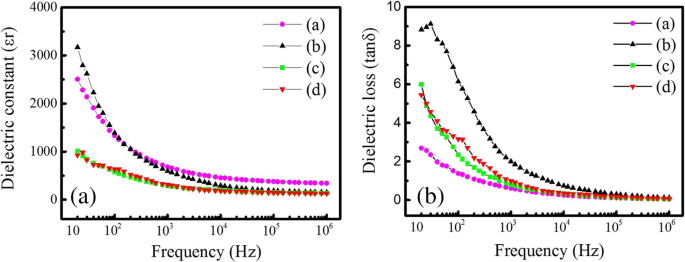
一 Dielectric constants (εr ) 和 b dielectric losses (tanδ ) of the PTO powders synthesized by MSS method and template MSS method. Samples (a) and (b) were synthesized by MSS method at 950 °C for 5 h with the molar ratios of PbC2O4:TiO2:NaCl:KCl equal to 1:1:30:30 and 1:1:60:60, respectively. Samples (c) and (d) were synthesized by template MSS method with the molar ratio of PbC2O4:TiO2 (rod-like template):NaCl:KCl equal to 1:1:60:60 and annealed 800 °C for 5 h and 10 h, respectively
结论
Both sphere- and rod-like PTO powders were synthesized by MSS and template MSS methods, respectively. XRD patterns reveal that all the PTO powders are crystallized in a tetragonal phase structure. SEM images demonstrated that increasing the molar ratio of PbC2O4:TiO2:NaCl:KCl from 1:1:10:10 to 1:1:60:60 in the MSS process had little effect on the sphere-like morphology of the PTO powders synthesized by MSS method. Large-scale polycrystalline rod-like PTO powders with length up to 10 μm and diameters in the range of 480 nm–1.50 μm were successfully synthesized by template MSS method at 800 °C for 5 h, where the rod-like anatase TiO2 precursors were used as a titanium source and the molar ratio of PbC2O4:TiO2:NaCl:KCl was equal to 1:1:60:60. It is found that under low molten salt content, extending the reaction time promoted the formation of sphere-like PTO particles whereas the formation of rod-like PTO particles was suppressed. In addition, the rod-like PTO powders cannot be synthesized even if the rod-like TiO2 templates are used. Dielectric measurements demonstrated that the dielectric constants of the sphere-like PTO powders synthesized by MSS method decreased fast from ~ 3000 to ~ 700 at low frequencies below 10 3 Hz, and at high frequencies over 10 5 Hz they became a constant value of ~ 340. The fast decrease of the dielectric constant at low frequencies is ascribed to the space charge polarization due to the non-uniform charges accumulated within the PTO powders. The rod-like PTO powders synthesized by template MSS method exhibited slight frequency-dependent dielectric behavior, their dielectric constants decreased slowly at the frequencies below 10 3 Hz and then remained a constant value of ~ 140 as the frequency increased up to 10 6 赫兹。 At room temperature, dielectric constant and dielectric loss (measured at 10 6 Hz) of the sphere-like PTO powders synthesized by MSS method at 950 °C for 5 h with low molten salt content (the molar ratio of PbC2O4:TiO2:NaCl:KCl equal to 1:1:30:30) were 340 and 0.06, respectively, and the corresponding values were 155 and 0.12 for the sphere-like PTO powders synthesized by MSS method with high molten salt content (the molar ratio of PbC2O4:TiO2:NaCl:KCl equal to 1:1:60:60). The dielectric constant and dielectric loss for the rod-like PTO powders synthesized by template MSS method at 800 °C for 5 h and 10 h under high molten salt content (the molar ratio of PbC2O4:TiO2 (rod-like template):NaCl:KCl equal to 1:1:60:60) were 140 and 0.08, and 130 and 0.07, respectively. The higher dielectric constant and lower dielectric loss of the sphere-like PTO powders synthesized at 950 °C for 5 h by MSS method with the molar ratio of PbC2O4:TiO2:NaCl:KCl equal to 1:1:30:30 are ascribed to their large average particle size (~ 2.0 μm), which have promising applications in multilayer capacitors and resonators.
缩写
- CALYPSO:
-
Crystal Structure AnaLYsis by Particle Swarm Optimization
- EDS:
-
Energy Dispersive Spectroscopy
- MSS:
-
Molten Salt Synthesis
- NP-9:
-
Polyoxyethylene (9) Nonylphenyl Ether
- PTO:
-
PbTiO3
- SEM:
-
Scanning Electron Microscopy
- XRD:
-
X-ray Diffraction
纳米材料
- 小型硒纳米晶体和纳米棒的简便合成和光学特性
- 通过溶胶-凝胶工艺制备的纳米结构二氧化硅/金-纤维素-键合氨基-POSS 混合复合材料
- 基于脂肪族环氧树脂和高氯酸锂盐的离子导电有机-无机聚合物复合材料的结构特性
- 接触非平衡等离子体对 Mn Х Fe3 − X О4 尖晶石结构和磁性能的影响
- 水对微晶和纳米纤维素结构和介电性能的影响
- 水溶性α-NaGdF4/β-NaYF4:Yb,Er核壳纳米粒子的合成和发光特性
- 用于有色冷色颜料的 Cr 掺杂 TiO2 的结构和可见近红外光学特性
- 水溶性硫化锑量子点的合成及其光电特性
- 通过蒸发诱导自组装和增强的气敏特性简便合成虫孔状介孔氧化锡
- 探测 Ag n V (n =1-12) 簇的结构、电子和磁特性
- 石墨烯/Ag3PO4 量子点复合材料的简便一步声化学合成和光催化性能
- 溶胶-凝胶改性的 pH 调节参数对纳米晶锶铁氧体的结构、微观结构和磁性的影响


